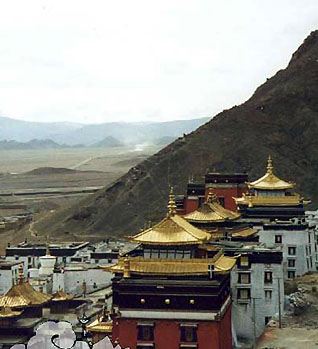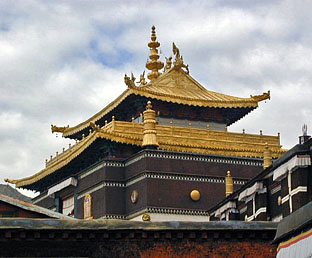|
Shigatse
|
|
Shigatse also
known as Xigatse is the second largest city in Tibet. Situated
at the junction of the Yarlong Tsangpo (Brahmaputra) and
Nyangchu River, Shigatse literally means "fertile land". This
600 year old city was earlier the capital of Tsang province
and now is the capital of Shigatse prefecture. It is an
important stop between Lhasa and west Tibet for pilgrims and
tourists. Shigatse has a population of over 80,000, of which
97% are Tibetan. It holds famous Tashilhunpo Monastery which
is the traditional seat of the Panchen Lama, who is one of the
two prestigious spiritual leaders in Tibet. Shigatse is fairly
developed city and well connected with all major cities of
Tibet by highways. Transportation in and out of Xigatse hugely
depends on road travel and buses are the main mode of
transportation on highways. Shigatse shows different climatic
conditions in summer and winter. The summer is usually mild
and wet, and brings most of the annual rainfall. Winter is
cold, dry and windy. The best time to travel to this city is
from May to July, when the temperature is neither too high nor
too low. |
 |
|
| |
|
Major Tourist Attractions |
|
 |
Shigatse has a
lot to offer to the tourists with its high snow capped peaks,
wonderful monasteries and colorful markets that are filled with
amazing Tibetan stuff. It is one of the favorite spots of
adventurers because most of the highest peaks in Tibet,
including Mt. Everest, are around Shigatse. Shigatse is right
place to shop original Tibetan handicraft items. It offers
appealing gold and silver ware, silk covers, traditional
bracelets, unique boots that become a kind of necessity during
Tibet travel as these are stitched suited to Tibetan terrain.
Apart from shopping and adventure, you can also enjoy number of
live performances of Tibetan opera, which is a specialty of
Shigatse city. The most popular site of the city, Tashilhunpo
Monastery is the biggest monastery of Gelugpa (or yellow hat
sect) in Tibet. |
|
| |
|
Tashilhunpo Monastery |
|
Tashilhunpo Monastery is located at the west part of the
Shigatse city and about 250 km away from the capital of
Tibet Lhasa. Situated on the foot of Drolmari or Tara’s
mountain, it is one of the huge Monasteries of Gelugpa (or
Yellow Hat Sect) in China and the biggest Tibetan Gelugpa
Buddhism monastery in back Tibet area. Standing on a
whooping area of around 300,000 sq. m it is also called the
Heap of Glory. It is known as a seat of the Panchen Lama who
is considered to be the second most important religious
leader of Tibet.
Founded by the
first Dalai Lama in the year 1447 the monastery
significantly expanded by the fourth and successive Panchen
Lamas. The Monastery covers an area of nearly 300,000 square
meters. |
 |
|
The main
structures found in the Monastery are The Maitreya Chapel, The Panchen Lama's Palace and The Kelsang
Temple. Tashilhunpo is the seat of the Panchen Lama since
the Fourth Panchen Lama took charge in the monastery, and
there are now nearly 800 lamas. When seen from entrance the
gran d building of monastery enchants the visitor with its
golden roofs and white walls. The Thangka Wall built by the
First Dalai Lama in 1468 is outstanding with its nine floor
high structure. The wall displays the images of Buddha on
the 14th, 15th and 16th of May every year following the
Tibetan Lunar Calendar. |
| |
|
The west side of
the monastery holds Maitreya Chapel, which houses the
biggest statue of a sitting Maitreya Buddha. The statue
stands 26.2 meters (86 ft) high and is adorned with gold,
copper, pearl, amber, coral, diamond and other precious
stones. About nine hundred artisans handcrafted this statue
in nine years. The Maitreya chapel has been divided into
five floors. There is wooden staircase in the chapel that is
used to visit the different floors of the chapel. One can
more clearly see the statue from the upper floors of the
chapel.
In the east of
the chapel lies the Stupa-tomb of the Tenth Panchen Lama.
Built in 1993 and enclosed by 1,354 pounds (614 kg) gold,
868 precious stones and 246,794 jewels, the Stupa-tomb is
the most splendid and expensive mausoleum in China since the
1950s. The Panchen Lama's Palace built during the reign of
the Six Panchen Lama stands nearby the Stupa-tomb, but it is
not opened for visitors. To the east of the Panchen Lama's
Palace lies the first stupa-tomb of Tashilhunpo. This stupa-tomb
belongs to the Fourth Panchen Lama who is one of the most
famous Lamas in Tibetan history. He was also the teacher of
the Fifth Dalai Lama. Ornamented with gold and silver this
magnificent stupa-tomb was built in 1662.
The another
significant building in Tashilhunpo is the Kelsang Temple.
It is one of the oldest and biggest buildings in Tashilhunpo.
It is a colossal compound. It has a Main Chanting Hall where
the lamas learn the sutras and listen to the Panchen Lama's
sermon. On the back end of the hall lies a 5 meters (16 ft)
high statue of Sakyamuni. It is said that a part of
Sakyamuni's relics was placed in it. There are two chapels
situated on both sides of the Main Chanting Hall. The left
one is devoted to Tara, the goddess who is believed to be
the avatar of Avalokitesvara. The chapel contains the
statues of White Tara (which is seated in the middle) and
two Green Taras on each side. The right chapel is devoted to
Maitreya Buddha. The chapel houses the statutes of Maitreya
Buddha, the Avalokitesvara and Bodhisattva Manjusri. The
Great Courtyard of the Kelsang Temple is used by the lamas
for practice and debate. Thousands of images of Sakyamuni in
different postures and expressions cover the wall around the
courtyard.
In addition to
the majestic palace and gigantic statues, the Tashilhunpo
Monastery also treasures distinctive murals. These murals
are notified for their variety of shapes, brilliant colors
and fine painting and are considered to be another
masterpiece of Buddhist art. Monastery also houses some rare
sutras, thangka, china and glass services of the Ming and
Qing Dynasties. Thus, Tashilhunpo Monastery helps you to
explore the history and society of Tibet. |
|
|
|
|

